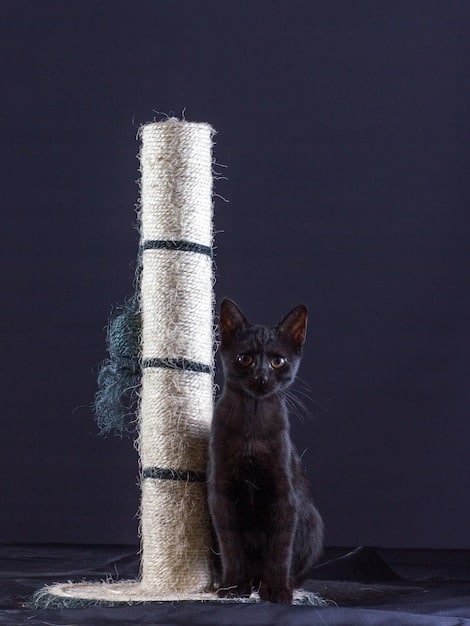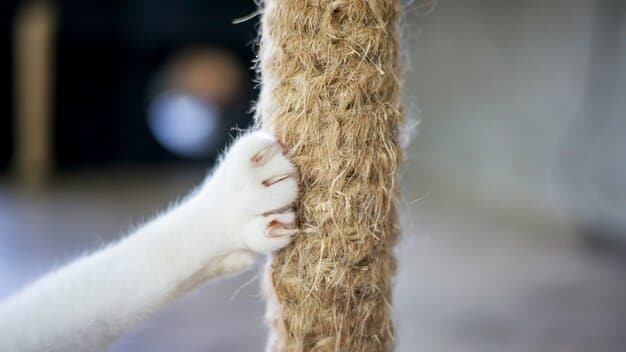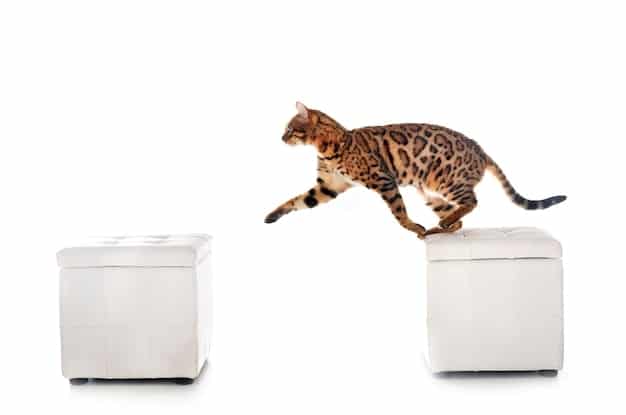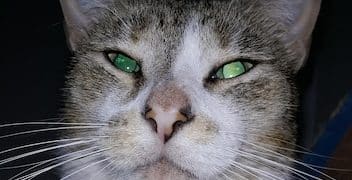Cat Scratching Solutions: Redirect Feline Clawing with Positive Training

Cat Scratching Solutions: Redirecting Feline Clawing with Positive Training involves understanding why cats scratch, providing appropriate scratching posts, using positive reinforcement techniques, and making unwanted targets less appealing to redirect scratching behavior effectively.
Is your furniture falling victim to your feline friend’s scratching habits? Discover effective cat scratching solutions: Redirecting feline clawing with positive training and creating a harmonious home for you and your cat.
Understanding Why Cats Scratch
Scratching is a natural and essential behavior for cats. It serves several purposes, from maintaining their claws to marking their territory. Understanding the reasons behind scratching is the first step in finding effective solutions.
Cats scratch for physical and emotional reasons. By understanding these motivations, you can provide appropriate outlets and redirect their behavior constructively.
Physical Needs
Scratching helps cats remove the dead outer layer of their claws, keeping them healthy and sharp. It also exercises their paws, legs, and back muscles. Providing suitable scratching surfaces allows them to perform these actions without damaging your furniture.
Emotional Needs
Scratching is a way for cats to mark their territory, both visually and through scent. They have scent glands in their paws that release pheromones when they scratch, signaling to other cats that this is their space. A scratching post can become a comforting and familiar object for your cat.

Here are some key points to consider:
- Claw Maintenance: Regular scratching keeps their claws in good condition.
- Muscle Exercise: It allows them to stretch and exercise their muscles.
- Territorial Marking: It helps them mark their territory with both visual marks and scent.
By understanding these needs, you can focus on cat scratching solutions: Redirecting feline clawing with positive training.
Providing appropriate scratching surfaces and understanding the underlying reasons for scratching will help you manage this behavior effectively.
Choosing the Right Scratching Post
Selecting the right scratching post is crucial for redirecting your cat’s scratching behavior. Different cats have different preferences for texture, size, and orientation. Experimenting with various options will help you find the perfect fit for your feline friend.
Consider the following factors when choosing a scratching post to ensure your cat uses it consistently.
Texture
Cats have preferences for different textures, such as sisal, carpet, wood, or cardboard. Sisal is a popular choice because it is durable and provides a satisfying texture for scratching. Observe your cat’s current scratching habits to determine their preferred texture and choose a post accordingly.
Size and Stability
The scratching post should be tall enough to allow your cat to fully stretch when scratching. A wobbly or unstable post can deter your cat from using it. Ensure the post is sturdy and won’t tip over during use.
Orientation
Some cats prefer vertical scratching posts, while others prefer horizontal surfaces. You can offer both types of posts to see which your cat prefers. Consider a scratching pad that lies flat on the ground or a vertical post that can be mounted on the wall.
Consider these options when cat scratching solutions: Redirecting feline clawing with positive training:
- Sisal Posts: Durable and satisfying for most cats.
- Cardboard Scratchers: A good option for cats who like to dig their claws in.
- Carpeted Posts: Choose a different texture than your household carpets to avoid confusion.
Selecting the right scratching post involves considering texture, size, and orientation to meet your cat’s individual needs.
By providing the right scratching post, you encourage your cat to use it instead of your furniture.
Placement Matters: Where to Put the Scratching Post
The location of the scratching post plays a significant role in whether your cat will use it. Placing the post in a high-traffic area or near objects they already scratch can increase its appeal.
Strategic placement will encourage your cat to use the scratching post more often.
High-Traffic Areas
Cats often scratch after waking up or when they are feeling playful. Placing the scratching post in a central location, such as the living room or hallway, ensures it is easily accessible and visible. Cats also like to scratch in areas where they spend a lot of time to mark their territory.
Near Existing Scratching Spots
If your cat is already scratching a particular piece of furniture, place the scratching post nearby. This allows them to easily transition to the new scratching surface. You can gradually move the post closer to its desired location over time.

Key considerations include:
- Visibility: Make sure the post is in a central location where the cat spends a lot of time.
- Accessibility: Place it near areas they already scratch.
- Stability: Ensure the post is stable to encourage regular use.
Proper placement of the scratching post is essential for effective cat scratching solutions: Redirecting feline clawing with positive training.
Strategic placement will make the scratching post more appealing and accessible to your cat.
Positive Reinforcement Techniques
Positive reinforcement is a powerful tool for encouraging desired behaviors in cats. Rewarding your cat when they use the scratching post will reinforce the behavior and make them more likely to use it in the future.
Using positive reinforcement techniques can effectively redirect your cat’s scratching habits.
Treats and Praise
Whenever you see your cat scratching the post, immediately offer a treat or praise. This positive association will encourage them to repeat the behavior. Use a high-value treat that your cat loves to make the reward even more effective.
Catnip
Sprinkling catnip on the scratching post can make it more appealing to your cat. Catnip contains a chemical called nepetalactone, which attracts many cats and stimulates them to play and scratch. Reapply catnip regularly to maintain its effectiveness.
Playtime
Engage your cat in playtime near the scratching post. Use toys that encourage them to reach and stretch, naturally leading them to the post. This helps associate the post with fun and positive experiences.
Consider incorporating these techniques:
- Immediate Rewards: Offer treats or praise right after they scratch the post.
- Catnip: Sprinkle catnip on the post to attract them.
- Interactive Play: Play with them near the post to create positive associations.
Positive reinforcement is a key component of effective cat scratching solutions: Redirecting feline clawing with positive training.
Rewarding your cat for using the scratching post will reinforce the desired behavior and make them more likely to use it consistently.
Making Unwanted Targets Less Appealing
While encouraging your cat to use the scratching post, it’s equally important to make unwanted targets, such as furniture, less appealing. There are several methods you can use to deter your cat from scratching these areas.
Making furniture less appealing can help redirect your cat’s scratching behavior to more appropriate surfaces.
Protective Covers
Covering your furniture with protective covers can prevent your cat from scratching it. Use materials that are unappealing to cats, such as plastic or aluminum foil. These covers create a barrier that deters them from scratching.
Scent Deterrents
Cats are sensitive to certain scents, such as citrus, lavender, and eucalyptus. Spraying these scents on your furniture can deter them from scratching. Be sure to use pet-safe products and test a small area first to ensure it doesn’t damage the fabric.
Double-Sided Tape
Applying double-sided tape to furniture can also deter scratching. Cats dislike the sticky texture and will avoid scratching surfaces covered in tape. This is a temporary solution that can be effective while you train your cat to use the scratching post.
Effective deterrents include:
- Furniture Covers: Use materials that cats dislike.
- Scent Sprays: Apply citrus or lavender scents.
- Double-Sided Tape: Cats dislike the sticky texture.
Making unwanted targets less appealing is an essential aspect of cat scratching solutions: Redirecting feline clawing with positive training.
By deterring your cat from scratching furniture, you can protect your belongings while encouraging them to use the scratching post.
Consistency and Patience
Redirecting your cat’s scratching behavior requires consistency and patience. It may take time for your cat to fully transition to using the scratching post. Stick to your training methods and celebrate small victories along the way.
Consistency and patience are key to success in redirecting your cat’s scratching habits.
Regular Reinforcement
Consistently reward your cat when they use the scratching post. This reinforces the desired behavior and helps them associate the post with positive experiences. Continue this reinforcement regularly, even after they are consistently using the post.
Avoid Punishment
Punishing your cat for scratching furniture can create fear and anxiety. This can lead to other behavioral problems and damage your relationship with your cat. Instead, focus on positive reinforcement and redirection techniques.
Remember these important principles:
- Consistent Rewards: Reinforce the behavior regularly.
- Avoid Punishment: Focus on positive methods.
- Be Patient: It takes time for cats to adjust.
Consistency and patience are crucial elements of effective cat scratching solutions: Redirecting feline clawing with positive training.
By maintaining consistency and being patient, you can successfully redirect your cat’s scratching behavior and create a harmonious environment for both you and your feline friend.
| Key Point | Brief Description |
|---|---|
| 🐾 Understanding Scratching | Scratching is natural for claw maintenance and territory marking. |
| ✅ Choosing Right Post | Offer various textures and stable posts for preference. |
| 🏠 Placement Matters | Put posts in high-traffic or near current scratching spots. |
| 🏆 Positive Reinforcement | Reward post usage with treats, catnip, or play. |
FAQ
▼
Cats might scratch furniture because they prefer the texture, height, or location compared to their scratching posts. Experiment with different posts and placements to find what your cat likes best.
▼
Make the new scratching post appealing by sprinkling catnip on it, playing with your cat near it, or placing it near their favorite scratching spot. Reward them when they use it.
▼
Declawing is generally not recommended as it’s a surgical procedure that can cause pain, behavioral issues, and long-term health problems. Redirecting scratching with positive training is a better option.
▼
Cats dislike certain scents like citrus, lavender, and eucalyptus. You can use pet-safe sprays with these scents on furniture to deter scratching. Always test a small area first.
▼
It varies depending on the cat’s age, personality, and consistency of training, but generally, it can take several weeks to a few months to see significant changes with positive reinforcement.
Conclusion
In conclusion, cat scratching solutions: Redirecting feline clawing with positive training involves understanding the reasons behind scratching, providing appealing scratching posts, employing positive reinforcement techniques, and making unwanted targets less attractive. With consistency and patience, you can successfully redirect your cat’s scratching behavior and protect your furniture while meeting your cat’s natural needs.





